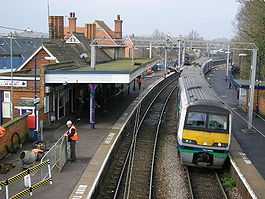Wivenhoe railway station
| Wivenhoe | |
|---|---|
 | |
| A Class 321 train at Wivenhoe railway station | |
| Location | |
| Place | Wivenhoe |
| Local authority | Colchester |
| Coordinates | 51°51′25″N 0°57′22″E / 51.857°N 0.956°ECoordinates: 51°51′25″N 0°57′22″E / 51.857°N 0.956°E |
| Grid reference | TM112214 |
| Operations | |
| Station code | WIV |
| Managed by | Greater Anglia |
| Number of platforms | 2 |
|
Live arrivals/departures and station information from National Rail Enquiries | |
| Annual rail passenger usage* | |
| 2004/05 | 0.319 million |
| 2005/06 | 0.321 million |
| 2006/07 | 0.331 million |
| 2007/08 | 0.335 million |
| 2008/09 | 0.329 million |
| 2009/10 | 0.309 million |
| 2010/11 | 0.330 million |
| 2011/12 | 0.354 million |
| History | |
| 8 May 1863 | Station opened as Wivenhoe |
| July 1879 | Renamed Wyvenhoe |
| October 1911 | Renamed Wivenhoe |
| National Rail – UK railway stations | |
| A B C D E F G H I J K L M N O P Q R S T U V W X Y Z | |
| * Annual estimated passenger usage based on sales of tickets in stated financial year(s) which end or originate at Wivenhoe from Office of Rail Regulation statistics. Methodology may vary year on year. | |
|
| |
Wivenhoe railway station is on the Tendring Hundred Railway (referred to informally as the Clacton line) and serves the small town of Wivenhoe in Essex, England. It is operated by Greater Anglia. The station has two platforms and a footbridge, and a manned ticket office and waiting room. It is only a short walk from the station to the River Colne at Wivenhoe quay, and the station car park is also the starting point of the Wivenhoe Trail, a cycle track that runs alongside the river into Colchester (about 4 miles).
History
The station was opened on 8 May 1863 by the Tendring Hundred Railway, which was worked by the Great Eastern Railway. Between July 1879 and October 1911 the name was spelled Wyvenhoe, after which it reverted to the original spelling Wivenhoe.[1]
A few hundred metres east of the station there was a junction for the single-track branch line to Brightlingsea. This branch was opened in 1866 and closed as part of the Beeching cuts in 1964 and the tracks lifted. The bridge over Alresford Creek was later demolished.
Service patterns
On Mondays to Saturdays, two trains depart in each direction per hour. In the 'up' (London) direction, one of these trains call at Colchester (North), Marks Tey, Witham, Chelmsford, Shenfield, Romford and Stratford before terminating at London Liverpool Street. The other 'up' train calls at Hythe and Colchester Town before terminating at Colchester (North).
In the 'down' (away from London) direction one train calls at Thorpe-le-Soken en route to Clacton-on-Sea. Another train calls at Alresford, Great Bentley, Weeley, Thorpe-le-Soken, Kirby Cross and Frinton-on-Sea before terminating at Walton-on-the-Naze.
On Sundays there is only one train per hour in each direction. The 'up' train calls at Colchester (North), Marks Tey, Witham, Chelmsford, Shenfield and Stratford (where London-bound trains set down) before terminating at Liverpool Street. The 'down' train calls at Alresford, Great Bentley and Thorpe-le-Soken en route to Clacton.
(Colchester Town, Hythe and Weeley are closed on Sundays. Stations on the Walton branch are accessed by an hourly Sunday shuttle from Thorpe-le-Soken.)
References
External links
- Train times and station information for Wivenhoe railway station from National Rail
| Preceding station | |
Following station | ||
|---|---|---|---|---|
| Hythe (Essex) Colchester |
Greater Anglia Sunshine Coast Line |
Alresford (Essex) | ||
| Disused railways | ||||
| Hythe Line and station open |
Great Eastern Railway Tendring Hundred Railway |
Brightlingsea Line and station closed | ||